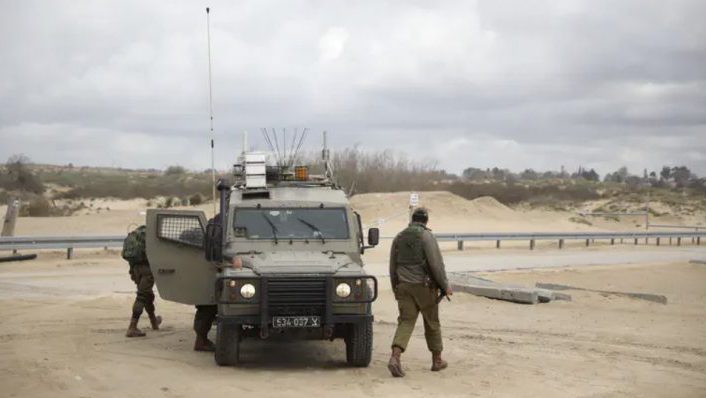IDF investigation reveals sufficient forces at Zikim, who withdrew instead of fighting back; 17 civilians and one soldier were murdered on the beach.
The operational debriefing of the battle on Zikim was completed and its findings were presented to the bereaved families and members of Kibbutz Zikim. The investigative team determined that the IDF had failed in its mission to protect the Zikim area. The ground forces, which fought on the coastline, failed in their mission and were unable to halt the terrorists’ advance on Zikim Beach. The Israeli Navy’s prevented the terrorists from reaching the Eilat Ashkelon Pipeline Company and the city of Ashkelon, thus reducing the extent of the attack on the beach and the kibbutz. The first response team of Kibbutz Zikim and other forces in the area, stopped the infiltration of the terrorists and thus saved the lives of many residents.
In the brutal attack seventeen civilians and two members of the security forces (one IDF soldier and one security service soldier) were murdered were murdered at Zikim Beach.
According to the findings of the investigation, thirty-eight terrorists infiltrated the Zikim area on seven boats, thirty-two terrorists were killed.
Sixteen minutes passed from the moment the first boat entered Israel’s maritime border until the seventh boat landed.
The investigation lasted several months and included interrogations of the fighting forces and civilians who were on the beach, the military operations logs, videos, documentation from observations, recordings and transcripts of communications, video clips from beach cameras, documentation from telephone and civilian photographs, video clips, photographs and intelligence materials, which all helped formulate a clear picture of the sequence of events that morning.
In light of the difficult and complex circumstances, there may have been inaccuracies in the investigation, and it is reasonable to assume that more details will be revealed in the future.
At 05:30, the battalion on guard carried out a “dawn alert”, according to orders and assessed the situation, declaring a routine situation, both in the ground forces and in the navy.
At 06:29 Hamas terrorists opened fire from the Gaza Strip at the western Negev communities, Zikim area and the military posts in the area. They infiltrated Israeli territory in cars and on motorcycles, by foot and paragliding, as well as from the sea on the Zikim beach. Within minutes, the sector was under a well-organized attack, in which the battalion and the navy forces were at a significant numerical disadvantage.
The following summarizes the principal findings from the investigation into the battle in the Zikim area:
A. Damage to the Ground Forces’ Command and Control Systems – In the initial minutes of the engagement, the command and control systems at the company, battalion, brigade, and division levels suffered severe damage. This significantly hindered the ability to establish an accurate operational picture. Commanders from the defense and reserve units, and sector levels were confined to the frontlines at an early stage of the conflict, resulting in a notable deficiency in commanders across the sector.
B. Deployment and Operation of Ground Forces – The alert force remained at the regional control post, within a protected area, for nine minutes. At 06:41, the unit mobilized toward Zikim Beach, acting under an incomplete understanding of the situation at that time. The soldiers executed a pre-established drill based on the assessment that a naval raid was underway. The investigation found that the composition and coordination of the military forces at Zikim Beach were adequate for the mission and could have effectively neutralized the terrorists disembarking from the fourth boat to arrive. However, the forces failed to distinguish the terrorists from civilians sheltering on the beach and did not engage with the enemy. As a result, their actions had negligible impact and did not alter the terrorists’ course of action. At 06:43, a tank from the Yiftach Company was deployed to assist in the battle, successfully halting the ground incursion toward Kibbutz Netiv HaAsara and the Yiftach base. Additional reinforcements arriving after the battle supported the evacuation of the wounded and conducted searches in the area.
C. Communication Between the Ashdod Naval Base and Kibbutz Zikim’s Security Chief – The investigation revealed that the update call at 06:40 between the Ashdod Naval Base operations room and the chief of security of Kibbutz Zikim, alerting to a maritime terrorist infiltration, was instrumental in enabling the alert squad to prepare approximately 23 minutes before engaging the terrorists. Continuous direct communication between the kibbutz security personnel and the Ashdod base contributed significantly to the response.
D. Alert Squad Readiness and Engagement – The preparedness and willingness of the alert squad to engage the enemy were decisive in halting the terrorists’ infiltration into the kibbutz, thereby saving the lives of its residents.
E. However, the investigation identified a serious failure concerning the delay in evacuating civilians who had been killed inside a shelter, an operation that was postponed for seven days. This delay was attributed to the multitude of incidents occurring concurrently in the area and the unsystematic approach of the Northern Brigade in managing civilian evacuation.
F. The investigation confirmed that both Zikim Beach and Kibbutz Zikim were premeditated targets of the Hamas attack on October 7. The maritime assault had been meticulously planned by Hamas.
G. Despite the scale of the naval attack and the failure to adequately protect civilians along the coastline, the Ashdod Naval force retained operational continuity, even though the maritime system and several radar and surveillance systems had been disabled, factors that significantly hindered situational knowledge, and command and control. Throughout the day, Ashdod Naval Base forces, in cooperation with ground units, successfully eliminated dozens of terrorists.
H. A naval vessel, returning from a mission to protect offshore infrastructure, awaited authorization for approximately one minute before opening fire, adhering to protocols designed to prevent friendly fire between naval and land forces. This delay proved to be a tactical error, enabling five of the seven terrorists from one boat to link up with five terrorists from another, thus facilitating their infiltration of Zikim Beach.The operational debriefing of the battle on Zikim was completed and its findings were presented to the bereaved families and members of Kibbutz Zikim. The investigative team determined that the IDF had failed in its mission to protect the Zikim area. The ground forces, which fought on the coastline, failed in their mission and were unable to halt the terrorists’ advance on Zikim Beach. The Israeli Navy’s prevented the terrorists from reaching the Eilat Ashkelon Pipeline Company and the city of Ashkelon, thus reducing the extent of the attack on the beach and the kibbutz. The first response team of Kibbutz Zikim and other forces in the area, stopped the infiltration of the terrorists and thus saved the lives of many residents.
In the brutal attack seventeen civilians and two members of the security forces (one IDF soldier and one security service soldier) were murdered were murdered at Zikim Beach.
According to the findings of the investigation, thirty-eight terrorists infiltrated the Zikim area on seven boats, thirty-two terrorists were killed.
Sixteen minutes passed from the moment the first boat entered Israel’s maritime border until the seventh boat landed.
The investigation lasted several months and included interrogations of the fighting forces and civilians who were on the beach, the military operations logs, videos, documentation from observations, recordings and transcripts of communications, video clips from beach cameras, documentation from telephone and civilian photographs, video clips, photographs and intelligence materials, which all helped formulate a clear picture of the sequence of events that morning.
In light of the difficult and complex circumstances, there may have been inaccuracies in the investigation, and it is reasonable to assume that more details will be revealed in the future.
At 05:30, the battalion on guard carried out a “dawn alert”, according to orders and assessed the situation, declaring a routine situation, both in the ground forces and in the navy.
At 06:29 Hamas terrorists opened fire from the Gaza Strip at the western Negev communities, Zikim area and the military posts in the area. They infiltrated Israeli territory in cars and on motorcycles, by foot and paragliding, as well as from the sea on the Zikim beach. Within minutes, the sector was under a well-organized attack, in which the battalion and the navy forces were at a significant numerical disadvantage.
The following summarizes the principal findings from the investigation into the battle in the Zikim area:
A. Damage to the Ground Forces’ Command and Control Systems – In the initial minutes of the engagement, the command and control systems at the company, battalion, brigade, and division levels suffered severe damage. This significantly hindered the ability to establish an accurate operational picture. Commanders from the defense and reserve units, and sector levels were confined to the frontlines at an early stage of the conflict, resulting in a notable deficiency in commanders across the sector.
B. Deployment and Operation of Ground Forces – The alert force remained at the regional control post, within a protected area, for nine minutes. At 06:41, the unit mobilized toward Zikim Beach, acting under an incomplete understanding of the situation at that time. The soldiers executed a pre-established drill based on the assessment that a naval raid was underway. The investigation found that the composition and coordination of the military forces at Zikim Beach were adequate for the mission and could have effectively neutralized the terrorists disembarking from the fourth boat to arrive. However, the forces failed to distinguish the terrorists from civilians sheltering on the beach and did not engage with the enemy. As a result, their actions had negligible impact and did not alter the terrorists’ course of action. At 06:43, a tank from the Yiftach Company was deployed to assist in the battle, successfully halting the ground incursion toward Kibbutz Netiv HaAsara and the Yiftach base. Additional reinforcements arriving after the battle supported the evacuation of the wounded and conducted searches in the area.
C. Communication Between the Ashdod Naval Base and Kibbutz Zikim’s Security Chief – The investigation revealed that the update call at 06:40 between the Ashdod Naval Base operations room and the chief of security of Kibbutz Zikim, alerting to a maritime terrorist infiltration, was instrumental in enabling the alert squad to prepare approximately 23 minutes before engaging the terrorists. Continuous direct communication between the kibbutz security personnel and the Ashdod base contributed significantly to the response.
D. Alert Squad Readiness and Engagement – The preparedness and willingness of the alert squad to engage the enemy were decisive in halting the terrorists’ infiltration into the kibbutz, thereby saving the lives of its residents.
E. However, the investigation identified a serious failure concerning the delay in evacuating civilians who had been killed inside a shelter, an operation that was postponed for seven days. This delay was attributed to the multitude of incidents occurring concurrently in the area and the unsystematic approach of the Northern Brigade in managing civilian evacuation.
F. The investigation confirmed that both Zikim Beach and Kibbutz Zikim were premeditated targets of the Hamas attack on October 7. The maritime assault had been meticulously planned by Hamas.
G. Despite the scale of the naval attack and the failure to adequately protect civilians along the coastline, the Ashdod Naval force retained operational continuity, even though the maritime system and several radar and surveillance systems had been disabled, factors that significantly hindered situational knowledge, and command and control. Throughout the day, Ashdod Naval Base forces, in cooperation with ground units, successfully eliminated dozens of terrorists.
H. A naval vessel, returning from a mission to protect offshore infrastructure, awaited authorization for approximately one minute before opening fire, adhering to protocols designed to prevent friendly fire between naval and land forces. This delay proved to be a tactical error, enabling five of the seven terrorists from one boat to link up with five terrorists from another, thus facilitating their infiltration of Zikim Beach.





